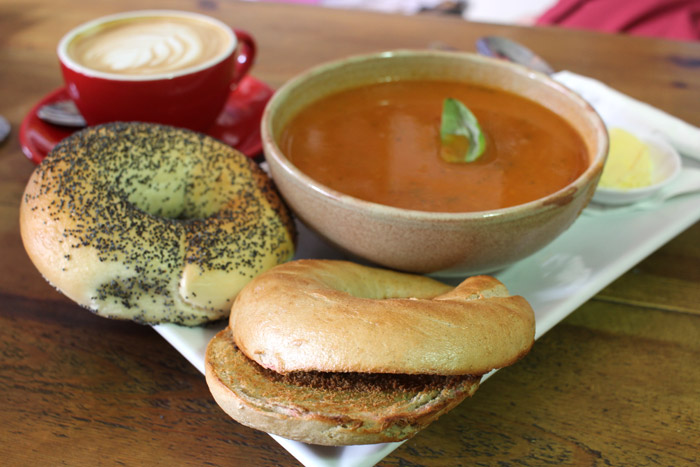What is a bagel?
A bagel, or beigel, is a dense wheat bread, raised with yeast and containing very little fat. Its two main distinguishing features are that it is shaped as a ring, and that it is first boiled in water and only then baked. This results in a firm, dense and chewy texture, yeasty-doughy taste, with a smooth and shiny appearance. Traditionally, bagels are topped with poppy or sesame seeds baked onto the crust, and often eaten with cured salmon and cream cheese — “lox and schmear”. Nowadays, new dough types are gaining popularity, such as wholegrain and rye; and dough additions that change the flavour, such as garlic, cheese, onion, cinnamon, raisin, blueberry or chocolate chips.

Bagels are regarded as Eastern European Jewish cuisine, later made popular by migrants in the United States. Traditional bagel dough contains high gluten wheat flour with no germ or bran, water, yeast and salt. Often bagel dough also contains a sweetener, such as barley malt, honey or sugar. Before anyone gets scared by the word ‘gluten’ — gluten it not unhealthy, unless someone truly has an intolerance, especially if refined white bread products are eaten only occasionally, as a treat, with preference for wholemeal and rye bread in everyday meals.
Bagels are made by mixing and kneading the dough ingredients, dividing and forming the dough into the ring shapes, slowly proofing at low temperature (5–10°C) for at least 12 hours, boiling each bagel in water for 1–1.5 minutes, and then baking in the oven at 175–300°C.
This seemingly unusual preparation method had its practical purpose: as cooking, baking and the kindling of a fire are prohibited on Shabbat, it allowed to use Shabbat as a productive time without breaking the cultural rules. The dough would be prepared on the day before the Shabbat, chilled and proofed during the Shabbat, and then quickly boiled and baked once the Shabbat ended. The shape of the bagel is practical too: it allows for a more even cooking and baking of the dough; and the hole can be used to thread a string or rods through for easier handling and transportation of large quantities of bagels and for setting a seller display.
“If it's not boiled, it's not a bagel.”
In recent years, the growing world-wide popularity of bagels gave rise to a so-called “steam bagel”, where the boiling step is skipped and the bagels are instead baked in a steam injection oven. This modified process is less labour-intensive and thus often used in commercial bagel production: the bagels only need to be handled once, when being shaped. After that, they stay on the trays for refrigeration and steam-baking. This results in a softer, fluffier and less chewy product, essentially being a bread roll that has a shape of a bagel. Genuine bagel makers, purists and bagel connoisseurs often say: “If it's not boiled, it's not a bagel!”
A properly made bagel should have such pleasant taste and distinct texture, that it is very nice to eat fresh, on its own, without toasting or any fillings. Jus a bagel with coffee, or tea if you prefer, or with a bowl of soup for a warming wither lunch.

Australian makers and sellers of real boiled bagels:
- The Bagel Boys 376 George St, Brisbane City, Queensland; thebagelboys.com.au
- The Bagel Boys 23 Cribb St, Milton, Queensland; thebagelboys.com.au
- Bury Me Standing Shop G, 49–51 Spence St, Cairns City, Queensland; burymestanding.com.au
- Bury Me Standing 83–85 Bathurst St, Hobart, Tasmania; burymestanding.com.au
- Bagels & Beans 1271 Hay St, West Perth, Western Australia
This list would love to grow. If any information on this page is out of date or can be expanded, please let me know.
Thank you for the interesting article and for the real bagel shop addresses!
Nathan, Australia, 21 May 2021
Just FYI, Bury Me Standing have opened a second cafe/shop about a year ago on Spence Street in Cairns.
Mila, 17 February 2023
Thank you. The new location has been added to the list.